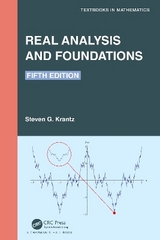
Real Analysis and Foundations
Productivity Press (Verlag)
9781498777681 (ISBN)
- Titel erscheint in neuer Auflage
- Artikel merken
a loyal readership and widespread use. Students find the book to be concise, accessible, and
complete. Instructors find the book to be clear, authoritative, and dependable.
The goal of this new edition is to make real analysis relevant and accessible
to a broad audience of students with diverse backgrounds. Real analysis
is a basic tool for all mathematical scientists, ranging from mathematicians to physicists to
engineers to researchers in the medical profession. This text aims to be the
generational touchstone for the subject and the go-to text for developing young
scientists.
In this new edition we endeavor to make the book accessible to a broader
audience. This edition includes more explanation, more elementary examples,
and the author stepladders the exercises. Figures are updated and clarified. We make
the sections more concise, and omit overly technical details.
We have updated and augmented the multivariable material in order to bring out
the geometric nature of the topic. The figures are thus enhanced and fleshed out.
Features
A renewed enthusiasm for the topic comes through in a revised presentation
A new organization removes some advanced topics and retains related ones
Exercises are more tiered, offering a more accessible course
Key sections are revised for more brevity
Steven G. Krantz is a professor of mathematics at Washington University in St. Louis. He has previously taught at UCLA, Princeton University, and Pennsylvania State University. He has written more than 65 books and more than 175 scholarly papers and is the founding editor of the Journal of Geometric Analysis. An AMS Fellow, Dr. Krantz has been a recipient of the Chauvenet Prize, Beckenbach Book Award, and Kemper Prize. He received a Ph.D. from Princeton University.
Number Systems
The Real Numbers
Appendix: Construction of the Real Numbers
The Complex Numbers
Sequences
Convergence of Sequences
Subsequences
Limsup and Liminf
Some Special Sequences
Series of Numbers
Convergence of Series
Elementary Convergence Tests
Advanced Convergence Tests
Some Special Series
Operations on Series
Basic Topology
Open and Closed Sets
Further Properties of Open and Closed Sets
Compact Sets
The Cantor Set
Connected and Disconnected Sets
Perfect Sets
Limits and Continuity of Functions
Basic Properties of the Limit of a Function
Continuous Functions
Topological Properties and Continuity
Classifying Discontinuities and Monotonicity
Differentiation of Functions
The Concept of Derivative
The Mean Value Theorem and Applications
More on the Theory of Differentiation
The Integral
Partitions and the Concept of Integral
Properties of the Riemann Integral
Change of Variable and Related Ideas
Another Look at the Integral
Advanced Results on Integration Theory
Sequences and Series of Functions
Partial Sums and Pointwise Convergence
More on Uniform Convergence
Series of Functions
The Weierstrass Approximation Theorem
Elementary Transcendental Functions
Power Series .
More on Power Series: Convergence Issues
The Exponential and Trigonometric Functions
Logarithms and Powers of Real Numbers
Differential Equations
Picard’s Existence and Uniqueness Theorem
The Form of a Differential Equation
Picard’s Iteration Technique
Some Illustrative Examples
Estimation of the Picard Iterates
Power Series Methods
Introduction to Harmonic Analysis
The Idea of Harmonic Analysis
The Elements of Fourier Series
An Introduction to the Fourier Transform
Appendix: Approximation by Smooth Functions
Fourier Methods and Differential Equations
Remarks on Different Fourier Notations
The Dirichlet Problem on the Disc
Introduction to the Heat and Wave Equations
Boundary Value Problems
Derivation of the Wave Equation
Solution of the Wave Equation
The Heat Equation
Functions of Several Variables
A New Look at the Basic Concepts of Analysis
Properties of the Derivative
The Inverse and Implicit Function Theorems
Appendix I: Elementary Number Systems
Appendix II: Logic and Set Theory
Appendix III: Review of Linear Algebra
| Erscheinungsdatum | 19.03.2017 |
|---|---|
| Reihe/Serie | Textbooks in Mathematics |
| Verlagsort | Portland |
| Sprache | englisch |
| Maße | 156 x 234 mm |
| Gewicht | 720 g |
| Themenwelt | Mathematik / Informatik ► Mathematik ► Analysis |
| ISBN-13 | 9781498777681 / 9781498777681 |
| Zustand | Neuware |
| Informationen gemäß Produktsicherheitsverordnung (GPSR) | |
| Haben Sie eine Frage zum Produkt? |
aus dem Bereich



